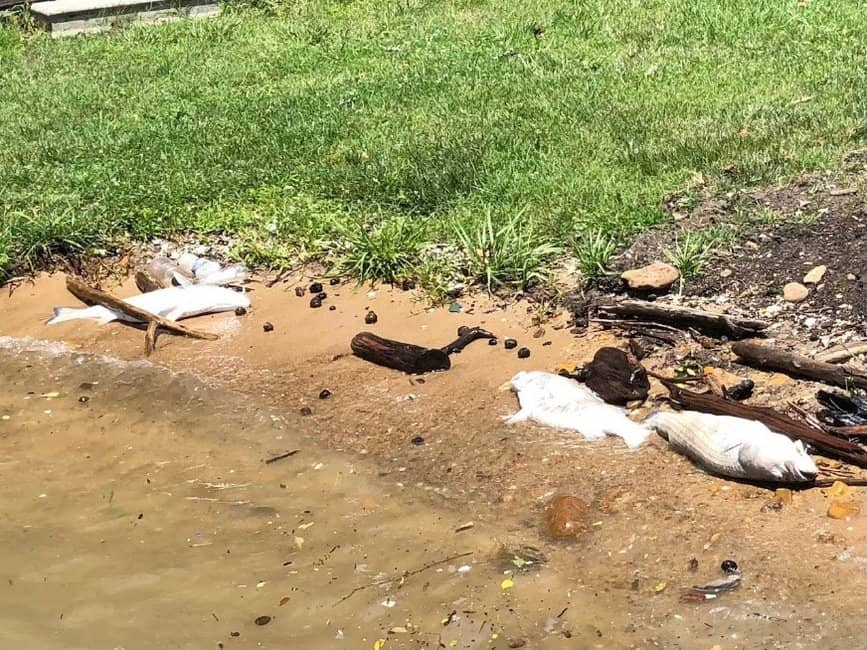Bass going belly up in Claytor, other lakes

By WILLIAM PAINE
For The Patriot
Those who have visited Claytor Lake in these past couple of weeks have undoubtedly noticed the unnerving sight of numerous fish floating belly up on the surface.
These fish range in size from a foot to almost three feet in length and judging from their girth, they look to have been well nourished before ultimately exposing their undersides to the sun.
Upon closer inspection and without exception, all of these fish bear the characteristics of their species in the form of thin reddish stripes that extend from head to tail along the fish’s flanks.
That is because the multitudes of dead fish currently floating on the waters of Claytor Lake belong to the species known as Striped Bass or Stripers. These tasty and often trophy sized specimens are definitely a fisherman’s favorite in the lakes of Appalachia.
But the fact is, these prized fish are dying off by the hundreds, as can be seen at Claytor Lake and some similarly situated lakes throughout the region.
So why are Stripped Bass meeting their demise in such a rapid rate?
Well, it turns out that this isn’t the first time this has happened. According to biologist Jeff Williams with the Virginia Department of Wildlife Resources, Striped Bass tend to die off in significant numbers in Claytor Lake and other mountain lakes when conditions combine to make this happen.
The recent hot weather is the biggest factor in bringing these fish to their end. According to Williams, the hot weather, combined with the lack of sufficient freshwater surges from tributary streams, have resulted in a notable, if not catastrophic, die off of Striped Bass.
The reason the Stripers are dying is a result of their inability to survive in warm waters. Recent surface temps at Claytor Lake are reaching 75 degrees Fahrenheit, and that’s too warm for the metabolism of the Striped Bass.
Because of their preference for cooler temps, Stripers like to stay in deeper waters of these mountain lakes, but these denser cooler waters present another issue for the summertime Striper.
According to Williams, the cooler, denser deep water and the warmer waters closer to the surface become stratified, so that they don’t readily mix.
The top layer of the lake is continually being oxygenated by contact with the atmosphere through turbulence caused by wind and waves.
In contrast, cooler waters far below the lake surface become slowly depleted of oxygen content over time and the effects of stratification prevent the oxygen rich surface waters from raising the oxygen levels below.
Stiped Bass are caught in an untenable position. The cool deep waters of the lake simply do not provide enough oxygen for these large fish and so they rise to the oxygen rich, yet vary warm waters close to the surface … where they die. Their metabolisms just can’t take the heat.
Stripers are hugely popular among the angler community and it’s no wonder. They grow to impressive sizes and are thoroughly tasty. Each year, the Virginia Department of Wildlife Resources stocks about 67,000 Striped Bass and 33,500 Hybrid Striped Bass into Claytor Lake.
No doubt they will be restocked in Claytor Lake as well as other lakes in Appalachian range for many years to come.
The Hybrid Striped Bass have a higher tolerance for heat and so are less susceptible to these die offs, but they do not grow to the size of Striped Bass and so are somewhat less popular among anglers.
Even so, there will likely be discussions about the Striped Bass’s viability in Claytor and other similar lakes, if these fish die offs grow in frequency or severity.
But atmospheric conditions that resulted in this Striper die off will surely change in the near future. More rain means more water flows into these lakes, which serves to cool them.
Even more significantly, cooler temperatures begin to prevail as Fall approaches. This cools the water’s surface, which in turn brings its density closer to that of the deeper lake water.
As a result, stratification becomes much less pronounced and deeper lake waters become more oxygenated in what is commonly referred to as Turning Over the Lake.
According to Williams, this “turning over” phenomenon occurs every Fall and serves to regenerate the lower depths of these lakes by naturally infusing them with more oxygen.
Meanwhile, some anglers on Claytor Lake are busy catching these big Stripers as they loiter close to the surface before dying.
This week has brought significant rainfall to the upper New River Valley watershed and as more cool stream water flows into the lake, this should serve to better the conditions for Striped Bass. By Wednesday of this week, there were noticeably fewer dead Stripers on the surface of Claytor Lake than just two days before. With more rain and cooler temperatures predicted in the coming days, it’s likely the Striped Bass Fishkill of 2022 will be over soon.


July 29, 2022 @ 3:34 pm
What is the estimated survival of the stocked striped and hybrid bass